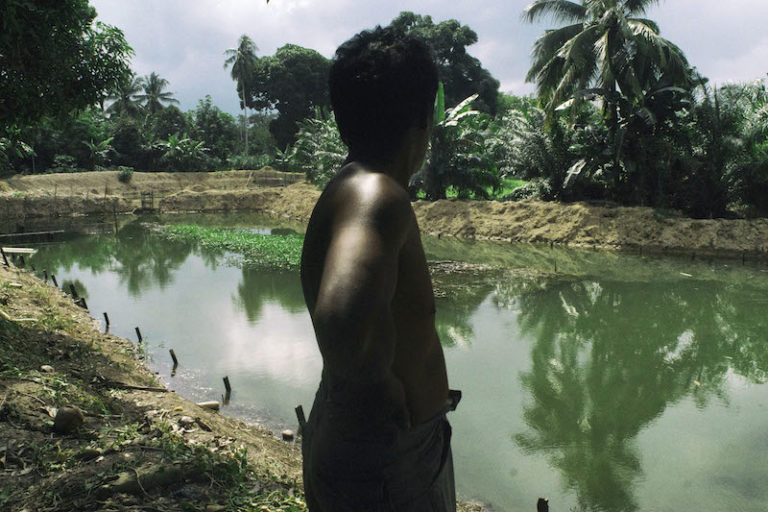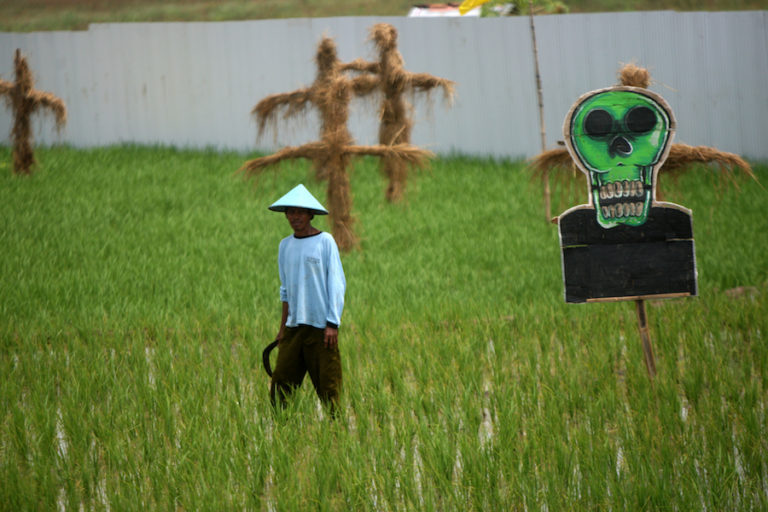Indonesia’s goal of achieving food self-sufficiency, especially for rice, might be in doubt as the country converts agricultural land into coal mining sites, a recent study found.
The report, launched in May by the environment NGOs Waterkeeper Alliance and the Mining Advocacy Network (JATAM), examines the impacts of coal concessions on Indonesia’s rice production at a time when the country is already likely to suffer reduced yields due to climate change.
The study concluded that around 1.7 million tons of rice per year has already been lost to coal mining and another 6 million tons per year of existing rice production is at risk if rice-growing areas that fall within exploration concessions are mined for coal.
If mining proceeds in coal concessions that fall within areas identified as suitable for new rice production, an additional 11 million tons of rice per year would be lost, says the report.
 Activists send a message in the middle of Ponowareng village rice fields to show their opposition to a coal-fired power plant in Batang, Central Java. Photo courtesy of Greenpeace.
Activists send a message in the middle of Ponowareng village rice fields to show their opposition to a coal-fired power plant in Batang, Central Java. Photo courtesy of Greenpeace.
Merah Johansyah, coordinator of the Mining Advocacy Network, said the amount of rice already determined to be lost due to mining is equivalent to the country’s annual rice imports.
“If things were managed properly, we wouldn’t need to import rice anymore,” said Johansyah at the report launch in Jakarta.
Analyzing government spatial planning maps, the researchers found that coal concessions cover 19 percent of the 44 million hectares (170,000 square miles) of rice-growing land in Indonesia — 1.6 million hectares within operating mining concessions and 6.5 million hectares within coal exploration concessions.
“This is only rice, we have yet to report on other crops,” said Johansyah, who called for a moratorium on mining in agricultural land.
 A farmer named Azis stands near his small fish pond, polluted by coal dust and chemicals in Santan Ilir village in Indonesian Borneo. Photo by Ardiles Rante/Greenpeace.
A farmer named Azis stands near his small fish pond, polluted by coal dust and chemicals in Santan Ilir village in Indonesian Borneo. Photo by Ardiles Rante/Greenpeace.
The impacts of mining
Coal mining, the report contends, depletes and contaminates water resources, leaving previously cultivable land unsuitable for growing food.
Mines reduce available ground- and surface water and pollute these vital resources with acidic drainage and heavy metals. Villagers living near coal mines reported having no option but to use mine pit water for washing, bathing, irrigation of crops and fish farming, and told researchers their rice yields were consequently reduced by 50 percent and fish production by 80 percent.
The researchers also analyzed water samples from 17 coal mining sites and surrounding waterways. All but two were found to have concentrations of aluminum, iron, manganese and/or pH balances likely to have an impact on crop production and fish farming.
For example, water samples taken from the largest mining site in East Kalimantan were found to have aluminum concentrations that exceeded by 21 times, and iron by 119 times, the U.S. Environmental Protection Agency’s maximum recommended concentrations for freshwater aquatic life.
Budi Haryanto, an environmental health expert at the University of Indonesia, said the minerals tested for — iron, aluminum and manganese —are required by the human body, but can be harmful above certain levels. “They found that these minerals exceeded standards,” he said, adding that coal contains additional damaging substances beyond those examined in the report.
According to the study, aluminum toxicity has been linked to neurological diseases such as Parkinson’s disease, amyotrophic lateral sclerosis, and Alzheimer disease.
High concentration of aluminum in water can also be deadly for fish.
 A farmer protests rice farm land which will be used for the Batang coal-fired power plant project. Photo by Wijaya S./Greenpeace.
A farmer protests rice farm land which will be used for the Batang coal-fired power plant project. Photo by Wijaya S./Greenpeace.
In plants, aluminum toxicity can reduce root systems, induces a variety of nutrient-deficiency symptoms and decreases yields. Iron toxicity causes similar problems, potentially resulting in poor plant growth and severe yield reductions at concentrations above 10 parts per million (ppm). For aquatic life, iron has been found to be harmful at concentrations as low as 1ppm.
“It turns out that there are no standards for heavy metals contamination in water used for agriculture, Johansyah said.
On the contrary, he added, Indonesian law allows abandoned mining sites to be used for housing, tourism, water and cultivation. “The regulation allows it and there’s no water quality monitoring as there are no standards,” he said. “There are regulations on water standards for agriculture but they do not give specific numbers.”
Haryanto emphasized that the factors examined in the report represent just a small fraction of the health and environmental dangers coal can cause.
“It means that you need to push it farther [from humans]. That’s how it should be regulated. There should not be water pollution or river pollution,” he said. “They [mine pits] should be buried, not turned into housing or containing water or parks.”









